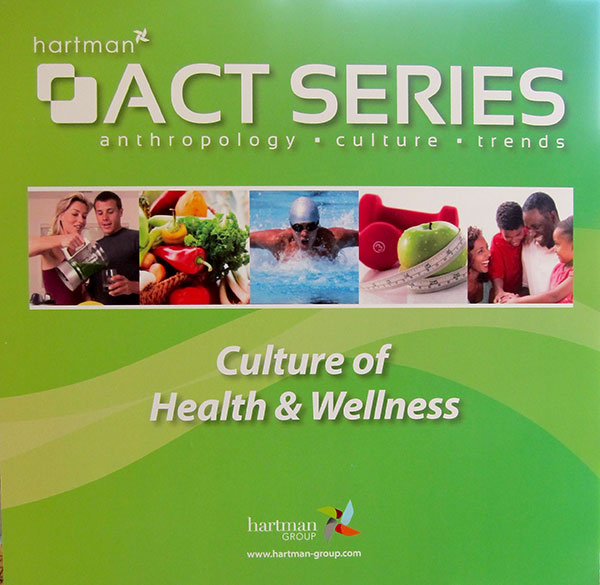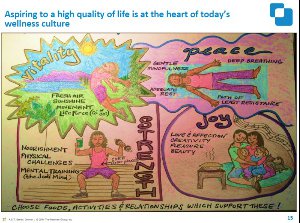A.C.T. Denver health and wellness is a wrap: Looking at consumers through a cultural lens
 At The Hartman Group’s A.C.T. Culture of Health & Wellness event in Denver earlier this summer, industry players from all over the country spent a day immersed in seeing and thinking like ethnographers steeped in the wisdom of culture. They learned how to target consumers based on their involvement in various arenas (wellness, organic, etc.) rather than typical demographic criteria — an approach that yields higher returns and better ongoing relationships with customers. For those who missed out, here’s a recap of the day:
At The Hartman Group’s A.C.T. Culture of Health & Wellness event in Denver earlier this summer, industry players from all over the country spent a day immersed in seeing and thinking like ethnographers steeped in the wisdom of culture. They learned how to target consumers based on their involvement in various arenas (wellness, organic, etc.) rather than typical demographic criteria — an approach that yields higher returns and better ongoing relationships with customers. For those who missed out, here’s a recap of the day:
“People don’t take care and start to feel bad and think it’s because they’re getting old. But it’s because they’re not paying attention and not taking care of themselves.”
That pearl of insight came from a Hartman Group interview out in the field and illuminates more than just the way consumers now view health and wellness. It’s also the way consumer brands operate. Taking care and paying attention are key to their success, and if they neglect those aspects of their business, brands will eventually become stale and decline.
To help companies pay closer attention to what consumers want, The Hartman Group offers a series of events called A.C.T. (Anthropology. Culture. Trends.) at which brand innovators and marketers learn to see consumers and purchasing behaviors the way our ethnographers do.
The quote above came from a presentation at The Hartman Group’s “Culture of Health & Wellness” event in Denver this summer, where people from all over the country spent a day immersed in seeing and thinking like ethnographers steeped in the wisdom of culture.
The quote comes from what we call a “Core” consumer in the health and wellness arena, someone steeped in the issues and likely to signal where the market is headed.
 Event participants learned how to target Core and other consumers with their products and services, and they learned why it’s important to look beyond surveys and focus groups to the details of consumers’ lives. Without in-person interviews and observations, a lot can be missed, including whether someone is telling the truth about eating gluten-free and how influenced their answers about millet are by people around them.
Event participants learned how to target Core and other consumers with their products and services, and they learned why it’s important to look beyond surveys and focus groups to the details of consumers’ lives. Without in-person interviews and observations, a lot can be missed, including whether someone is telling the truth about eating gluten-free and how influenced their answers about millet are by people around them.
In Denver, we demonstrated what we call “the power of the small ‘n’” with a consumer panel that answered questions from attendees about health and wellness — a subject that naturally includes attitudes toward exercise but quickly turned toward food. Some panelists said they buy packaged foods, while others — closer to the “Core” — talked about looking to local, fresh and whole foods as a means of staying healthy.
Panel moderator Tamara Barnett, senior director of strategic insights at The Hartman Group, asked the consumers to share information about their lives as well, because people do not live and consume in a vacuum. They’re affected by the culture in which they operate — whether exhausted professionals finding lunch between meetings or recent college grads independently managing food choices while balancing tight budgets. Everyone makes choices in the context of their family and career backgrounds, as well as the broader arena in which their supermarkets or dollar stores are stocked.
Going even deeper, researchers find that food, beverage and lifestyle choices stem from beliefs about various things — for example, what’s adventurous, comforting, delicious and healthy.
Take kimchi. An underlying reason this fermented Korean delight has gained favor in recent years, appearing in high-end restaurants and on trendy food-truck menus, is that people want to aid their digestion — something they think is important to overall health. By eating kimchi, they combine flavor exploration with feeling good.
It’s the same reason people avoid some other foods — those that are processed or contain gluten, dairy, soy, sugar or corn: They think eating some things and avoiding others makes them feel better, and following self-imposed rules gives them a controlled way in which to explore alternatives.
By tracing the beliefs that underlie food and wellness trends, food companies can align their brands with consumers’ values and more easily predict where shoppers might end up next. Product innovators and marketers do that by immersing themselves in culture — the context in which people live — so they can more easily understand what people want and how to communicate with them.
As Stas Shectman, a senior ethnographic analyst at The Hartman Group, put it, companies do best when they see themselves as partnered with consumers. It’s our hope that the latest A.C.T. event brought attendees closer to achieving that dynamic.
